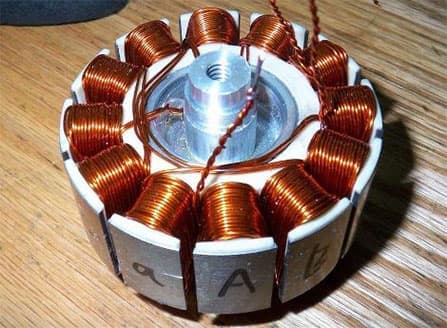Magnet winding wire In electric motors
Copper windings in a miniaturized electric motor
Electric motors convert electrical energy into mechanical motion, usually through the interaction of magnetic fields and current-carrying conductors. Electric motors are found in numerous diverse applications, such as fans, blowers, pumps, machines, household appliances, power tools, and disk drives. The very largest electric motors with ratings in the thousands of kilowatts are used in such applications as the propulsion of large ships. The smallest motors move the hands in electric wristwatches.
Electric motors contain coils to produce the required magnetic fields. For a given size of motor frame, high conductivity material reduces the energy loss due to coil resistance. Poorer conductors generate more waste heat when transferring electrical energy into kinetic energy.

Because of its high electrical conductivity, copper is commonly used in coil windings, bearings, collectors, brushes, and connectors of motors, including the highest quality motors. Copper’s greater conductivity versus other materials enhances the electrical energy efficiency of motors. For example, to reduce load losses in continuous-use induction-type motors above 1 horsepower, manufacturers invariably use copper as the conducting material in windings. Aluminium is an alternate material in smaller horsepower motors, especially when motors are not used continuously.
One of the design elements of premium motors is the reduction of heat losses due to the electrical resistance of conductors. To improve the electrical energy efficiency of induction-type motors, load loss can be reduced by increasing the cross section of copper coils. A high efficiency motor will usually have 20% more copper in the stator winding than its standard counterpart.
Early developments in motor efficiency focused on reducing electrical losses by increasing the packing weight of stator windings. This made sense since electrical losses typically account for more than half of all energy losses, and stator losses account for approximately two‐thirds of electrical losses.
There are, however, disadvantages in increasing the electrical efficiency of motors through larger windings. This increases motor size and cost, which may not be desirable in applications such as appliances and in automobiles.
